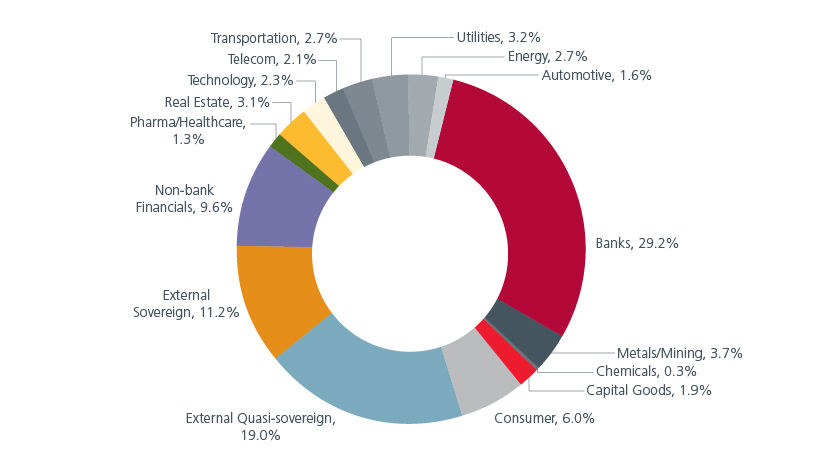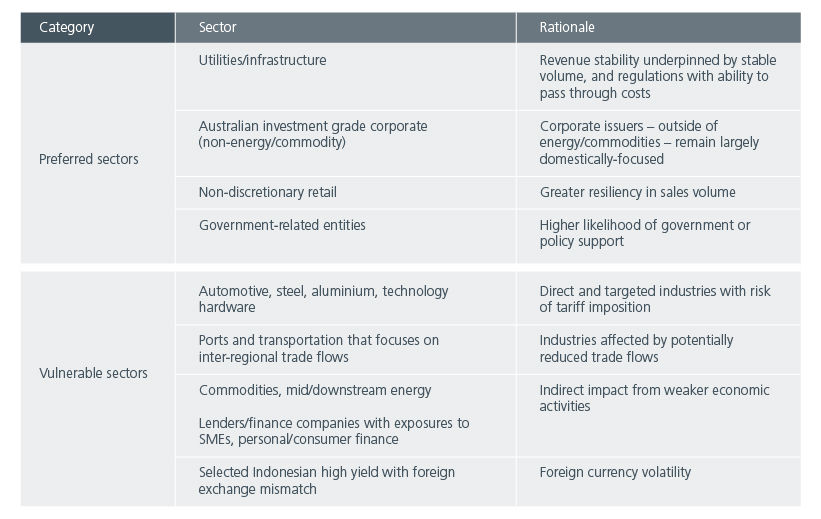Executive Summary
- Vast majority of Asia Pacific USD bond issuers are relatively insulated from US tariffs due to their domestic focus
- The uncertain outlook calls for dexterity in sector/issuer selection and portfolio positioning
- We advocate a more defensive stance and prefer investment grade and selected strong high yield credits
Like other asset classes, the Asian bond market has endured meaningful volatility since the announced Liberation Day tariffs. As a reference, the Z-spread of the investment grade (IG) part of the JP Morgan Asian Credit Index has widened by around 30bps since 2 April 2025. While the swift pricing reaction is understandable, nimble and careful sector and issuer selections will enable investors to navigate through the uncertainty.
Fig 1: Asian investment grade spreads widened sharply

Source: Bloomberg, JP Morgan Asia Credit Index IG as at 7 April 2025
Asian credits started the year strong
Asian credits began the year with sound financial positions; the average leverage1 of Asian IG issuers (excluding Chinese real estate) was estimated to be a healthy ratio of 1.1x. IG issuers have also maintained healthy liquidity, helped by manageable debt maturity profiles and supportive funding markets.
We expect the vast majority of Asia-Pacific (APAC) USD bond issuers to be relatively insulated from the risk of direct tariff impositions by the US, given their domestically focused business profiles. However, the second-order impact from an uncertain economic outlook could pose a challenge.
Sizing up the tariff impact
A small number of APAC bond issuers – especially in the car, steel and aluminium industries – are already subject to tariff impositions by the US but these make up a small percentage of the region’s bond markets. As of 31 March 2025, the metals/mining (which include steel and aluminium issuers) and automotive sectors made up around 4.3% of the JP Morgan Asia Pacific Credit Index which includes Japan and Australia.
Fig 2: Sector breakdown of the JACI Asia Pacific index

Source: JP Morgan, 31 March 2025
The impending trade uncertainty is more likely to have second-order impact on the macroeconomic outlook of the region. This will occur through weaker economic demand, investment activities and personal consumption. Trade-dependent economies are more likely to feel the brunt of slower economic activities. For selected economies, foreign currency pressures could also affect the credit outlook of issuers, to the extent that there are material foreign currency mismatches.
Potential winners and losers
The tariff situation remains fluid with various economies posturing for remedial or retaliatory actions against the US. Investors need to understand the specific impact on different sectors and the altered trade dynamics. The uncertain outlook calls for dexterity in sector/issuer selection and portfolio positioning. On the whole, it is not all bad news for Asia-Pacific credits. We advocate a more defensive stance and prefer investment grade and selected strong high yield credits.
Sector wise, we prefer those that benefit from domestic consumption such as utilities, infrastructure, non-discretionary retail, as well as government-linked entities that enjoy strong support and are less susceptible to tariff or macroeconomic-induced uncertainties. We expect these sectors to enjoy more resilient funding access given their defensive credit profile.
Fig 3: Assessment of tariff impact on sectors

In general, we prefer investment grade issuers given their stronger financial and liquidity positions. In the high-yield space, we are more selective and will wait for the right opportunities should there be further pricing volatility.
Sources:
1 Leverage defined as Net debt/EBITDA estimated by JP Morgan as of 2024
The information and views expressed herein do not constitute an offer or solicitation to deal in shares of any securities or financial instruments and it is not intended for distribution or use by anyone or entity located in any jurisdiction where such distribution would be unlawful or prohibited. The information does not constitute investment advice or an offer to provide investment advisory or investment management service or the solicitation of an offer to provide investment advisory or investment management services in any jurisdiction in which an offer or solicitation would be unlawful under the securities laws of that jurisdiction.
Past performance and the predictions, projections, or forecasts on the economy, securities markets or the economic trends of the markets are not necessarily indicative of the future or likely performance of Eastspring Investments or any of the strategies managed by Eastspring Investments. An investment is subject to investment risks, including the possible loss of the principal amount invested. Where an investment is denominated in another currency, exchange rates may have an adverse effect on the value price or income of that investment. Furthermore, exposure to a single country market, specific portfolio composition or management techniques may potentially increase volatility.
Any securities mentioned are included for illustration purposes only. It should not be considered a recommendation to purchase or sell such securities. There is no assurance that any security discussed herein will remain in the portfolio at the time you receive this document or that security sold has not been repurchased.
The information provided herein is believed to be reliable at time of publication and based on matters as they exist as of the date of preparation of this report and not as of any future date. Eastspring Investments undertakes no (and disclaims any) obligation to update, modify or amend this document or to otherwise notify you in the event that any matter stated in the materials, or any opinion, projection, forecast or estimate set forth in the document, changes or subsequently becomes inaccurate. Eastspring Investments personnel may develop views and opinions that are not stated in the materials or that are contrary to the views and opinions stated in the materials at any time and from time to time as the result of a negative factor that comes to its attention in respect to an investment or for any other reason or for no reason. Eastspring Investments shall not and shall have no duty to notify you of any such views and opinions. This document is solely for information and does not have any regard to the specific investment objectives, financial or tax situation and the particular needs of any specific person who may receive this document.
Eastspring Investments Inc. (Eastspring US) primary activity is to provide certain marketing, sales servicing, and client support in the US on behalf of Eastspring Investment (Singapore) Limited (“Eastspring Singapore”). Eastspring Singapore is an affiliated investment management entity that is domiciled and registered under, among other regulatory bodies, the Monetary Authority of Singapore (MAS). Eastspring Singapore and Eastspring US are both registered with the US Securities and Exchange Commission as a registered investment adviser. Registration as an adviser does not imply a level of skill or training. Eastspring US seeks to identify and introduce to Eastspring Singapore potential institutional client prospects. Such prospects, once introduced, would contract directly with Eastspring Singapore for any investment management or advisory services. Additional information about Eastspring Singapore and Eastspring US is also is available on the SEC’s website at www.adviserinfo.sec. gov.
Certain information contained herein constitutes "forward-looking statements", which can be identified by the use of forward-looking terminology such as "may", "will", "should", "expect", "anticipate", "project", "estimate", "intend", "continue" or "believe" or the negatives thereof, other variations thereof or comparable terminology. Such information is based on expectations, estimates and projections (and assumptions underlying such information) and cannot be relied upon as a guarantee of future performance. Due to various risks and uncertainties, actual events or results, or the actual performance of any fund may differ materially from those reflected or contemplated in such forward-looking statements.
Eastspring Investments companies (excluding JV companies) are ultimately wholly-owned / indirect subsidiaries / associate of Prudential plc of the United Kingdom. Eastspring Investments companies (including JV’s) and Prudential plc are not affiliated in any manner with Prudential Financial, Inc., a company whose principal place of business is in the United States of America.













